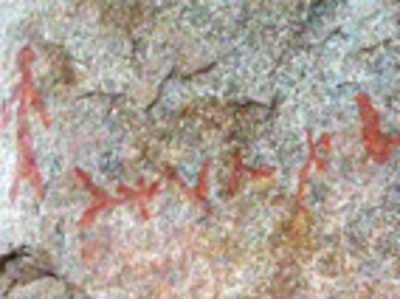Prof sees Harappan script in Hampi

This could turn out to be one of the biggest archaeological finds in South India. Dr KM Metry, professor of tribal studies at the Kannada University, Hampi, has found prehistoric paintings on a hilltop in Hampi, which he claims is
The series of 20 characters found resembles the Late Harappan writing of the
Speaking to Mirror, Metry said, “There is a direct link between the Late Harappan and the writings that have been discovered. This proves that the people of Indus Valley Civilisation moved to South India after the collapse of the Late Harappan stage.”
Dr Motiravan Kangale and Prakash Kalame, who had claimed deciphering the Harappa script relating it to the ancient tribal Gondi script, are helping decipher the writing found in Hampi, Metry said. The discovery was made near Talwara Ghatta on the way to Vijaya Vittala Temple in the UNESCO World Heritage Site.
“Dr Kangale and Kalame were in Hampi between August 24 and 29 for a seminar on the Gondi language. I took them to these writings. On the spot, Kangale was able to decipher five of the 20 characters,” Metry said. The professor said that the symbols resemble symbols on the famous Pasupati Seal found in Mohenjo-Daro. “There are other such writings of symbols similar to these in other places in Hampi. Once all are studied, we can prove that the Harappans migrated to South India and a crucial link in our prehistory can be established.”
However, historians are calling for caution. Eminent historian Dr S Shettar said, “Recently there were claims of a Harappan engraving on a piece of stone in Tamil Nadu. But unlike a rock face, stone pieces and seals can travel long distances. In this case too, we need very solid evidence. If the discovery is true, it is wonderful. But it has to be viewed very carefully. From about 2000 BCE when the Harappan/Indus civilisation ended and the times of Ashoka in the 3rd Century BCE, we do not have clarity of the continuity in Indian history. The Indus civilisation has been demarcated as Early, Mature and Late Harappan.
“But the writings found there are not as clearly demarcated. Even the true nature of the Harappan writings is in question. So if you find a discovery beyond the conventional Indus Civilisation area, you have to be very careful while making any claims. You need to say which language was used, which script was used and the continuity. A language or script cannot remain stagnant for 1,000 years. This cannot happen with a single find. Let there not be empty speculation,” he said.
A BYGONE ERA
Out of the 20 symbols, Kangale and Kalame were able to immediately decipher five, says Metry. "They are: Sl No 1, which means aalin in Gondi, manava in Kannada, and man in English; Sl No 3, nel in Gondi, nela/nellu in Kannada, paddy field in English; Sl No 8, sary in Gondi, sari/daari in Kannada, way/path in English; Sl No 15, sukkum in Gondi, chukke in Kannada, star/dot in English; and Sl No 16, nooru in Gondi, nara manava/ mukhanda in Kannada, headman in English.
GALLERIES View more photos
























